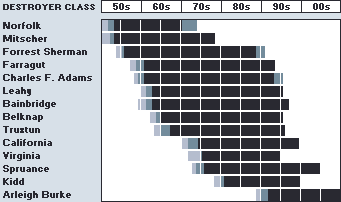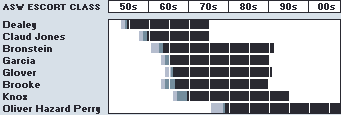
New destroyer classes of the 1950s and ’60s joined large numbers of Fletcher, Allen M. Sumner and Gearing classes from World War II, which were supplanted by the Spruance class in the late 1970s. All were replaced in turn by the Arleigh Burke-class Aegis destroyers, which began commissioning in the 1990s.

Of the smaller destroyers, the first to commission were eighteen ships of the 2,780-ton Forrest Sherman class. These “last gunships” introduced a main armament of three 5-inch/54 caliber rapid fire guns on an enlarged hull with increased freeboard forward for improved seakeeping. Beginning in 1955, the Shermans joined ships of the Fletcher, Allen M. Sumner and Gearing classes that had remained the core of the destroyer force during the ten years since World War II. In the early 1960s, they were in turn joined by 23 destroyers of the Charles F. Adams class, similar in design but with an even more pronounced sheerline and guided missiles.
Preceding the Forrest Shermans into commission were the first classes of larger all-weather task force escorts. Initially designated DL (“destroyer leaders”), these “frigates” began appearing in 1951 with Norfolk and continued with the Mitscher, Farragut, Coontz, Leahy and Belknap classes. In 1975 these were reclassified as guided missile destroyers or cruisers; some served until 1994. Bainbridge of 1962 was a nuclear-powered adaptation of Leahy. She was followed by Truxtun and two California-class and two Virginia-class nuclear-powered frigates. All ships of these classes in commission in 1975 were reclassified as cruisers (two addtional Virginia-class ships were launched as cruisers).
While anti-submarine warfare (ASW) escort classes introduced in the 1950s were soon phased out, those from the ’60s remained in operation into the 1990s when they were superseded by Oliver Hazard Perry-class frigates, the only class in commission today.

These new classes of the 1950s and ’60s were not followed until 1975, when the first of 31 9,250-ton Spruance-class destroyers introduced gas turbine propulsion in a hull design later shared by the Ticonderoga-class cruisers. Four Kidd-class ships, modified Spruances originally intended for Iran, commissioned in 1981 and ’82. The destroyers in which today’s generations of reunion attendees served, these guided missile classes were superseded only when the Arleigh Burke-class Aegis destroyers began to arrive in the 1990s, portending their retirement—some while still in excellent condition but too expensive to operate in the 21st century for the capabilities they offered.
The US Navy’s purpose-built ASW escorts, initially referred to as “ocean escorts” (DE) but, from 1975, redesignated as “frigates” (FF), evolved from the destroyer escorts of World War II when it became apparent that leftover Fletchers, Allen M. Sumners and Gearings could not accommodate the electronics necessary for anti-submarine warfare. While the first-generation Dealey and Claud Jones classes introduced in the 1950s were retired by the mid-1970s, those introduced in the 1960s—the Bronstein, Garcia, Glover, Brooke and Knox classes—remained in US Navy service until the end of the 1980s and into the ’90s, when their mission was taken over by the Oliver Hazard Perry-class frigates.